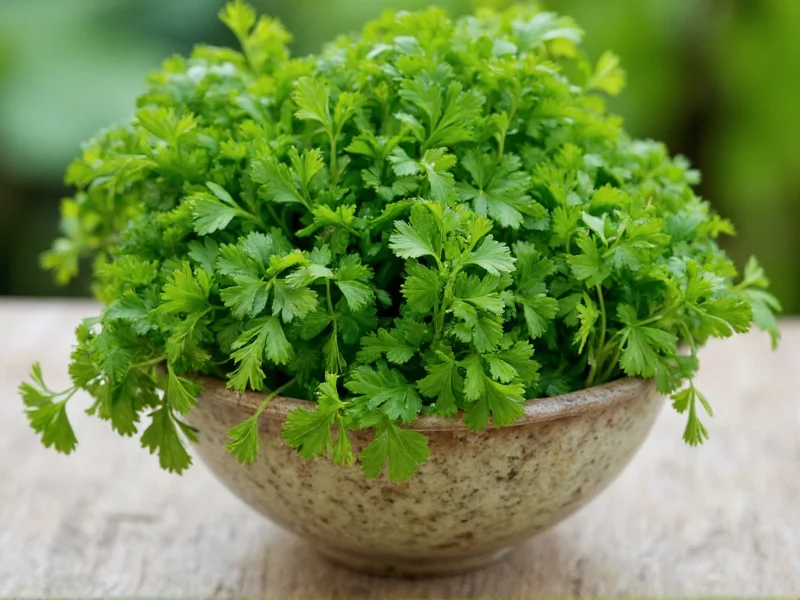Understanding parsley substitution goes beyond simple measurements. Fresh parsley contains about 85% water, which evaporates during the drying process, concentrating the herb's essential oils and flavors. This concentration explains why you need less dried parsley to achieve similar flavor intensity.
Why the 3:1 Ratio Works Best
Dried herbs generally have three times the flavor concentration of their fresh counterparts. When you remove moisture from parsley, the remaining compounds become more potent. Using equal amounts would result in overpowering, sometimes bitter flavors that alter your dish's intended taste profile.
Flavor Profile Differences You Should Know
Fresh parsley offers bright, grassy notes with subtle peppery undertones, while dried parsley develops earthier, more muted characteristics. The drying process diminishes volatile compounds responsible for fresh parsley's vibrant aroma. This difference matters most in dishes where parsley plays a starring role rather than a supporting one.
| Measurement Conversion | Fresh Parsley | Dried Parsley |
|---|---|---|
| Basic Substitution | 3 teaspoons (1 tbsp) | 1 teaspoon |
| Per Recipe Cup | 1 cup chopped | ⅓ cup |
| Per Recipe Ounce | 1 ounce | ⅓ ounce |
When Substitution Works Best
Dried parsley performs well in cooked dishes where extended heating time allows flavors to develop gradually:
- Stews and soups (add dried parsley early in cooking)
- Marinades for meats
- Sauces that simmer for 30+ minutes
- Casseroles and baked dishes
- Dry rubs and seasoning blends
Situations Where Fresh Parsley Is Essential
Certain applications require fresh parsley's unique qualities that dried simply can't replicate:
- Garnishes (dried won't provide visual appeal)
- Persillade and other fresh herb blends
- Tabbouleh and similar fresh herb-heavy salads
- Pesto variations
- Finishing touches added after cooking
Maximizing Dried Parsley Flavor in Substitutions
Follow these professional techniques when replacing fresh with dried:
- Rehydrate first: Mix dried parsley with 1 teaspoon of warm water or broth and let sit for 5 minutes before adding to recipes
- Add early: Incorporate dried herbs at the beginning of cooking to allow flavors to develop
- Taste and adjust: Wait 15-20 minutes after adding dried parsley before final seasoning
- Boost with acid: A splash of lemon juice can help revive some fresh-like qualities
Storage Impact on Substitution Accuracy
The age of your dried parsley significantly affects substitution ratios. Properly stored dried parsley (in airtight container away from light and heat) maintains potency for 1-2 years. Older dried herbs lose potency, requiring slightly more than the standard ratio. Test older dried parsley by rubbing a small amount between your fingers—if the aroma is weak, increase the amount by 25%.
Common Substitution Mistakes to Avoid
Cooks often make these errors when substituting dried for fresh parsley:
- Using equal measurements instead of adjusting for concentration
- Adding dried parsley at the end of cooking (results in harsh, undeveloped flavor)
- Substituting in raw applications where fresh texture matters
- Not accounting for the age of dried herbs
- Using dried parsley in place of flat-leaf varieties in delicate dishes
Practical Recipe Applications
Consider these real cooking scenarios when substituting:
Pasta Sauce: For a recipe calling for 2 tablespoons fresh parsley, use 2 teaspoons dried added during the last 20 minutes of simmering. The extended cooking time allows flavors to mellow appropriately.
Roasted Vegetables: When a recipe specifies ¼ cup chopped fresh parsley for finishing, use 1½ tablespoons dried mixed with olive oil and tossed with vegetables during the last 10 minutes of roasting.
Homemade Salad Dressing: Avoid substituting dried parsley in vinaigrettes—it won't rehydrate properly. Fresh parsley is essential for emulsified dressings.











 浙公网安备
33010002000092号
浙公网安备
33010002000092号 浙B2-20120091-4
浙B2-20120091-4